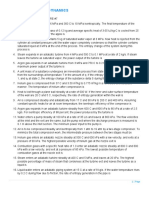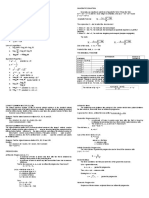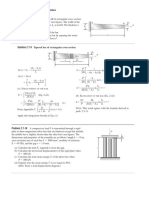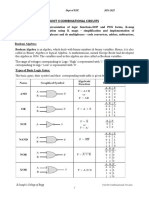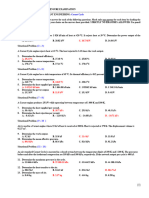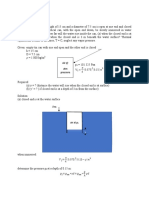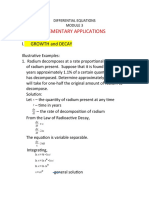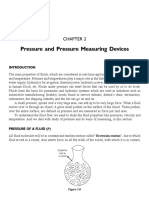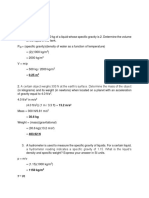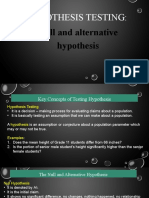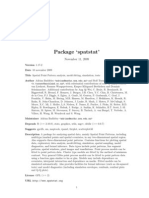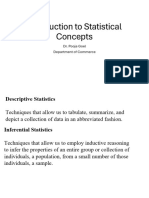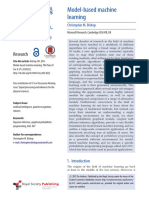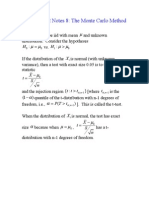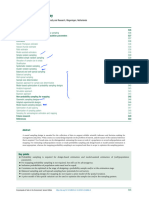Problem Set #1 in MATH 403
Problem Set #1 in MATH 403
Uploaded by
Jason MojadoCopyright:
Available Formats
Problem Set #1 in MATH 403
Problem Set #1 in MATH 403
Uploaded by
Jason MojadoOriginal Title
Copyright
Available Formats
Share this document
Did you find this document useful?
Is this content inappropriate?
Copyright:
Available Formats
Problem Set #1 in MATH 403
Problem Set #1 in MATH 403
Uploaded by
Jason MojadoCopyright:
Available Formats
Republic of the Philippines
BATANGAS STATE UNIVERSITY
The National Engineering University
Alangilan Campus
Golden Country Homes, Alangilan, Batangas City, Batangas,
Philippines 4200 Tel No. (+63 43) 425-0139 loc. 2121 / 2221
E-mail Address: ceafa@g.batstate-u.edu.ph | Website Address: http://www.batstate-u.edu.ph
College of Engineering
Department of Electronics Engineering
Math 403 – Engineering Data Analysis
Problem Set No. 1
Name: Jason B. Mojado Section: ECE 2101
SR Code: 22-05888 Date:
Directions: Solve the following problems completely. Include the graphs/tables for probability
distribution problems.
1. If A, B, and C are mutually exclusive events with P (A) = 0.2, P(B) = 0.3, and P(C) = 0.4,
determine the following probabilities:
a. P(A ∪ B ∪ C) c. P(A ∩ B) e. P(A’ ∩ B’ ∩ C’)
b. P(A ∩ B ∩ C) d. P[(A ∪ B) ∩ C]
Given that :
P(A) = 0.2
P(B) = 0.3
P(C) = 0.4
a) P(A ∪ B ∪ C) = P (A) + P(B) + P(C)
= 0.2 + 0.3 + 0.4 = 0.9
b) P(A ∩ B ∩ C) = P(A) + P(B) + P(C) - P(A ∩ B) - P(B ∩ C) - P(A ∩ C) - P( A ∩ B ∩ C )
= 0.2 + 0.3 + 0.4 - 0.9
=0
c) P(A ∩ B) = 0
d) P[(A ∪ B) ∩ C] = P ( A ∪ B ) + P(C) - P(A ∪ B ∪ C )
= P(A) + P (B) + P(C) - 0.9
= 0.2 + 0.3 + 0.4 - 0.9
=0
e) P(A’ ∩ B’ ∩ C’) = 1- P ( A ∪ B ∪ C )
= 1 - 0.9
= 0.1
Leading Innovations, Transforming Lives
2. A lot of 100 semiconductor chips contain 20 that are defective. Two are selected randomly,
without replacement, from the lot.
a. What is the probability that the first one selected is defective?
From the given information ,a lot of 100 semiconductor chips contain 20 that are defective.
Total no. of chips = 100
No. of defectives = 20
Let : A = event that the first one selected is defective
B = events that the second one selected is defective
P(A) = 20𝐶₁/100𝐶₂
= 20/100
= 0.2
b. What is the probability that the second one selected is defective given that the first
one was defective?
The probability that second one selected is defective given that the first one was
defective is,
P(B⏐A) = P(A ∩ B) /P(A)
20 19
×
= 100
20
99
100
19
= 99
= 0.1919
c. What is the probability that both are defective?
P(A ∩ B)= P(A) P(B)
d. How does the answer to part (b) change if chips selected were replaced prior to the
next selection?
Leading Innovations, Transforming Lives
3. Suppose 2% of cotton fabric rolls and 3% of nylon fabric rolls contain flaws. Of the rolls used
by a manufacturer, 70% are cotton and 30% are nylon. What is the probability that a randomly
selected roll used by the manufacturer contains flaws?
For a random fabric roll of this manufacturer define events:
A - It is a cotton fabric roll
B - it contain flaws
P(B) = ?
P(B⏐A) = 0.02
P(B⏐A’)= 0.03
P(A’) = 0.3
P(A) = 0.7
Now we use the total probability rule for two events
P(B) = P(B⏐A)P(A) + P(B⏐2-7)’(A)
= 0.02 · 0.7 + 0.03 · 0.3
= 0.023
4. Marketing estimates that a new instrument for the analysis of soil samples will be very
successful, moderately successful, or unsuccessful, with probabilities 0.3, 0.6, and 0.1,
respectively. The yearly revenue associated with a very successful, moderately successful, or
unsuccessful product is $10 million, $5 million, and $1 million, respectively. Let the random
variable X denotes the yearly revenue of the product. Determine the probability mass function of
X.
X P(X)
10 0.3
5 0.6
1 0.1
f(10)= P (X= $10 million) = 0.3
f(5)= P (X= $5 million) = 0.6
f(1)= P (X= $1 million) = 0.1
Leading Innovations, Transforming Lives
5. An assembly consists of three mechanical components. Suppose that the probabilities that the
first, second, and third components meet specifications are 0.95, 0.98, and 0.99. Assume that the
components are independent. Determine the probability mass function of the number of
components in the assembly that meet specifications.
X is the number of components that are in line with specifications, it can take on values 0,1,2,3
Let:
A - the first component meets specifications
B - the second component meets specifications
C - the third component meets specifications
Given:
A, B, C are independent
P(A) =0.95 ⇒P(A′)=0.05
P(B)=0.98 ⇒P(B′)=0.02
P(C)=0.99 ⇒P(C′)=0.01
Probability mass function of X (called f) is found using property (3) of its definition:
f(0) =P(X=0)
=P(A′∩B′∩C′)
=P(A′)P(B′)P(C′)
=0.05⋅0.02⋅0.01
=0.00001
f(1) =P(X=1)
=P[(A′∩B′∩C)∪(A′∩B∩C′)∪(A∩B′∩C′)]
=P(A′∩B′∩C)+P(A′∩B∩C′)+P(A∩B′∩C′)
=P(A′)P(B′)P(C)+P(A′)P(B)P(C′)+P(A)P(B′)P(C′)
=0.05⋅0.02⋅0.99+0.05⋅0.98⋅0.01+0.95⋅0.02⋅0.01
Leading Innovations, Transforming Lives
=0.00167
Using the same properties:
f(2) =P(X=2)
=P[(A′∩B∩C)∪(A∩B′∩C)∪(A∩B∩C′)]
=P(A′)P(B)P(C)+P(A)P(B′)P(C)+P(A)P(B)P(C′)
=0.05⋅0.98⋅0.99+0.95⋅0.02⋅0.99+0.95⋅0.98⋅0.01
=0.07663
f(3) =P(X=3)
=P(A∩B∩C)
=P(A)P(B)P(C)
=0.95⋅0.98⋅0.99
=0.92169
For x other than 0,1,2,3, f(x)=P(X=x)=0
Using the definition of probability mass function and independence calculate
f(0)=0.00001, f(1)=0.00167, f(2)=0.07663, f(3)=0.92169
f=0 everywhere else.
6. Marketing estimates that a new instrument for the analysis of soil samples will be very
successful, moderately successful, or unsuccessful, with probabilities 0.3, 0.6, and 0.1,
respectively. The yearly revenue associated with a very successful, moderately successful, or
unsuccessful product is $10 million, $5 million, and $1 million, respectively. Let the random
variable X denote the yearly revenue of the product. Determine the probability mass function of X.
The probability mass function of the yearly revenue of the product is given in the text of the
exercise:
f (10) = P( X = 10) = 0.3
f (5) = P (X = 5 ) = 0.6
f (1) = P ( X = 1) = 0.1
Leading Innovations, Transforming Lives
7. The probability density function of the length of a metal rod is f(x) = 2 for 2.3 < x < 2.8 meters.
a. If the specifications for this process are from 2.25 to 2.75 meters, what proportion of the bars
fail to meet the specifications?
b. Assume that the probability density function is f(x) = 2 for an interval of length 0.5 meters. Over
what value the density should be centered to achieve the greatest proportion of bars within
specifications?
Step 1
The probability density function f of the random variable X is given as:
f(x)=2, 2.3 < x < 2.8
Straightforward calculation gives:
a)
P(2.25 X 2.75) = P(2.3 < X < 2.75) = 2 x (2.75 -2.3)=0.9
Therefore, 1 - 90% = 10% of the rods are not within expectation.
b)
If we suppose that X is centered around r = 2.5, the probability density formula is
transformed into:
f(x)=2, 2.25 < x < 2.75
and easy calculation gives:
P(2.25 X 2.75) = 2 x 0.5=1
Therefore, the answer is 2.5
8. Suppose the time it takes a data collection operator to fill out an electronic form for a database is
usually between 1.5 and 2.2 minutes.
a. What is the mean and variance of the time it takes the operator to fill out the form? b. What
is the probability that it will take less than two minutes to fill out the form? c. Determine the
cumulative distribution function of the time it takes to fill out the form.
Let X be a random variable with continuous uniform distribution over the interval
[1.5, 2.2. with the pdf:
Leading Innovations, Transforming Lives
9. Suppose that X is a binomial random variable with n = 200 and p = 0.4
a. Approximate the probability that X is less than or equal to 70
b. Approximate that the probability of X is greater than 70 and less than 90.
Let X be the binomial random variable with the parameters:
n=200
p=0.4
Then, the random variable Z defined as:
is approximately standard normal random variable with the cumulative distribution Φ listed in the
tables on the back of the textbook.
Calculate using the continuity corrections and the tables:
a. P (X ≤ 70 ) - P(X ≤ 70.5 ) ≈ P 𝑍 ≤ ( 70.5 − 80
4 3 )
= Φ(−1.37)
= 0.0853
b. P(70lt;X lt;90)
=P(71≤X≤89)=P(70.5≤X≤89.5)≈P(−1.37≤Z≤1.37)=
=2Φ(1.37)−1≈0.83
10. In a large corporate computer network, user log-ons to the system can be modeled as a Poisson
process with a mean of 25 log-ons per hour. What is the probability that there are no logons in an
interval of 6 minutes?
Using the Poisson distribution, it is found that there is a:
a) 0.0821 = 8.21% probability that there are no logons in an interval of 6 minutes.
−11
b) 1.3887× 10 probability that the distance between two log-ons be more than one hour.
We are given only the mean, hence, the Poisson distribution is used.
In a Poisson distribution, the probability that X represents the number of successes of a random
variable is given by:
Leading Innovations, Transforming Lives
−µ 𝑥
𝑒 µ
P (X = x) = 𝑥!
The parameters are:
x is the number of successes
e = 2.71828 is the Euler number
𝜇 is the mean in the given interval.
Item a:
6
Mean of 25 log-ons per hour, hence, in 6 minutes, the mean is of µ = 60
× 25 = 2. 5
The probability is P(X = 0), hence:
−µ 𝑥
𝑒 µ
P (X = x) = 𝑥!
−2..5 0
𝑒 2.5
P (X = x) = 0!
= 0.0821
0.0821 = 8.21% probability that there are no logons in an interval of 6 minutes.
Item b:
This is the probability of no log-ons in one hour, which is P(X = 0) with , then:
−µ 𝑥
𝑒 µ
P (X = x) = 𝑥!
−25 0
𝑒 25 −11
P (X = x) = 0!
= 1. 3887 × 10
−11
1. 3887 × 10 probability that the distance between two log-ons be more than one hour.
Leading Innovations, Transforming Lives
You might also like
- Homework 1Document3 pagesHomework 1Shaban Malik100% (1)
- Chapter 1 - MEDocument10 pagesChapter 1 - MEMd. Azmain AdilNo ratings yet
- 4 ProbabilityDocument86 pages4 ProbabilityChrysler GepigaNo ratings yet
- CF Chapter 11 Excel Master StudentDocument40 pagesCF Chapter 11 Excel Master Studentjulita08No ratings yet
- COMIA, JOHN LLOYD B - Exercises-No.1Document7 pagesCOMIA, JOHN LLOYD B - Exercises-No.1John Lloyd ComiaNo ratings yet
- Electrical Circuits 1Document286 pagesElectrical Circuits 1RJ MCNo ratings yet
- ECE 424 - Assign2Document2 pagesECE 424 - Assign2Amos AtandiNo ratings yet
- Laboratory Number 3: EE-406 Electrical MachinesDocument25 pagesLaboratory Number 3: EE-406 Electrical Machines3AE Jhan Rodrigo V. EspinoNo ratings yet
- EM 7 - EDA - Problem Set 1Document2 pagesEM 7 - EDA - Problem Set 1Ron Michael Dave Cezar0% (1)
- Group 2 - Problem Set ACDocument6 pagesGroup 2 - Problem Set ACNeil Jelo MarasiganNo ratings yet
- Module 3 BDocument48 pagesModule 3 BBu DakNo ratings yet
- DC Circuit TheoremsDocument75 pagesDC Circuit TheoremsRohit SinghNo ratings yet
- Fundamentals of Thermodynamics: Borgnakke SonntagDocument47 pagesFundamentals of Thermodynamics: Borgnakke SonntagJkun gamingNo ratings yet
- Math403 - 4.0 Continuous Probability DistributionDocument42 pagesMath403 - 4.0 Continuous Probability DistributionMae FalcunitinNo ratings yet
- Newton's Universal Law of Gravitation: A Lecture On General Physics 1 by Engr. Jackielou D. DecenaDocument53 pagesNewton's Universal Law of Gravitation: A Lecture On General Physics 1 by Engr. Jackielou D. DecenaSpace MonkeyNo ratings yet
- SAQ 7-ThermodynamicsDocument2 pagesSAQ 7-Thermodynamicsjhigs amfufuNo ratings yet
- Tangent Secant Chord Diameter RadiusDocument10 pagesTangent Secant Chord Diameter RadiusShannon May Ancheta PasulNo ratings yet
- PDF 3 Mechanics of DBDocument12 pagesPDF 3 Mechanics of DBeysNo ratings yet
- Activity No. 8 Impedance of Inductance, Resistance and Capacitance CircuitDocument5 pagesActivity No. 8 Impedance of Inductance, Resistance and Capacitance CircuitJohn Paul BaquiranNo ratings yet
- Math PDFDocument78 pagesMath PDFneil manalo50% (2)
- Experiment 2Document9 pagesExperiment 2Daniel Naoe Festin100% (1)
- Therm Tutorial 1Document3 pagesTherm Tutorial 1Rajat Varshney0% (1)
- 02-06 Chap Gere PDFDocument16 pages02-06 Chap Gere PDFAnonymous 15awgX0NaNo ratings yet
- Electronic Devices Experiment 4Document13 pagesElectronic Devices Experiment 4ArvinALNo ratings yet
- F TransformsDocument36 pagesF TransformsMizanur Rahman100% (1)
- Module 2Document16 pagesModule 2GRAVES JAKENo ratings yet
- DLC Unit 2Document69 pagesDLC Unit 2kkr kkrNo ratings yet
- Velocity AccelerationDocument72 pagesVelocity Accelerationhamock.dir1No ratings yet
- Carnot Cycle Review ProblemsDocument1 pageCarnot Cycle Review ProblemsAllaine BartolomeNo ratings yet
- Chapter 2: Resistive Circuits: BEE1133: Circuit Analysis IDocument44 pagesChapter 2: Resistive Circuits: BEE1133: Circuit Analysis IHarung Salim BachikNo ratings yet
- App AnnDocument14 pagesApp AnnKashmir RedondoNo ratings yet
- Problems Differential EquationsDocument121 pagesProblems Differential EquationsRazes50% (4)
- Chapter 1A Basic Concepts PDFDocument14 pagesChapter 1A Basic Concepts PDFChristian MuliNo ratings yet
- ES 31 - Thermodynamics and Heat TransferDocument5 pagesES 31 - Thermodynamics and Heat Transferyeng botzNo ratings yet
- C-5 - Examples: Air at Atm PressureDocument20 pagesC-5 - Examples: Air at Atm PressureIuhence VergaraNo ratings yet
- ENSC 14a Problem Set 1Document3 pagesENSC 14a Problem Set 1deusleanNo ratings yet
- Vibration - Introduction3 - Damped VibrationDocument22 pagesVibration - Introduction3 - Damped VibrationArnob DasNo ratings yet
- Basic Electrical Engineering Final Examination MEDocument1 pageBasic Electrical Engineering Final Examination MEDian Enmu0% (1)
- Numerical Analysis-1Document84 pagesNumerical Analysis-1El Hafad BaraNo ratings yet
- 14 Fourier Integral Fourier Transform (Zill, Dennis G) ..Document21 pages14 Fourier Integral Fourier Transform (Zill, Dennis G) ..Putra BangsawanNo ratings yet
- Volume CentroidDocument6 pagesVolume CentroidZsaneen Mariz Tulabut100% (1)
- Impedance of A Series RLC CircuitDocument12 pagesImpedance of A Series RLC Circuit2XWinNo ratings yet
- Elementary Applications: I. Growth and DecayDocument5 pagesElementary Applications: I. Growth and DecayJuvilee RicoNo ratings yet
- Standard Normal DistributionDocument89 pagesStandard Normal DistributionYsa AuxerreNo ratings yet
- Orca Share Media1535596930012Document64 pagesOrca Share Media1535596930012Julia Latawan LasilasNo ratings yet
- Transformer Tests Objectives: Ee - 19 Module 4Document12 pagesTransformer Tests Objectives: Ee - 19 Module 4Mark Anthony GarciaNo ratings yet
- Module 3Document18 pagesModule 3NICOLE ANN MARCELINONo ratings yet
- Lecture Notes 1 - Fluid Mechanics - 1Document7 pagesLecture Notes 1 - Fluid Mechanics - 1Jane AndaNo ratings yet
- 2 Magnetic CircuitsDocument48 pages2 Magnetic CircuitsShubham ThakurNo ratings yet
- Pressure and Pressure Measuring Devices: Brownian Motion", Due To WhichDocument23 pagesPressure and Pressure Measuring Devices: Brownian Motion", Due To WhichSamuel GaétanNo ratings yet
- Worked Examples On Buoyancy and FloatationDocument8 pagesWorked Examples On Buoyancy and FloatationMekuanint ShitawNo ratings yet
- Radiation Formula SheetDocument5 pagesRadiation Formula SheetJakeJosephNo ratings yet
- Fluid MechanicsDocument6 pagesFluid MechanicsPAULINO ALCARAZ JRNo ratings yet
- ELEC4100 Complete NotesDocument150 pagesELEC4100 Complete NotesShittyUsername2013No ratings yet
- B. Electricity - Basic PrinciplesDocument4 pagesB. Electricity - Basic PrinciplesXyxy LofrancoNo ratings yet
- Solutions 10Document12 pagesSolutions 10JCLLNo ratings yet
- CALTECH HANDOUT 2nd YEAR 1 PDFDocument9 pagesCALTECH HANDOUT 2nd YEAR 1 PDFPrincess NobleNo ratings yet
- Frequency and Period ProblemDocument18 pagesFrequency and Period ProblemImmortal DynastyNo ratings yet
- ch02 5Document4 pagesch02 5yi LeeNo ratings yet
- GenmathDocument8 pagesGenmathPaulina PaquibotNo ratings yet
- ECE 6337 HW 1-7 and Soln 1-7Document19 pagesECE 6337 HW 1-7 and Soln 1-7Sose ManukNo ratings yet
- Statistics Mcqs Paper 2013Document2 pagesStatistics Mcqs Paper 2013zeb4019100% (1)
- M3 - Q3.xlsx (Updated)Document14 pagesM3 - Q3.xlsx (Updated)Kit Lester BalayoNo ratings yet
- Kumpul Modul 2Document107 pagesKumpul Modul 2InnabilaNo ratings yet
- Null and Alternative HypothesisDocument36 pagesNull and Alternative HypothesisMicael Paña Alejandro BernardoNo ratings yet
- L1 Random Variables and Probability Distribution PDFDocument7 pagesL1 Random Variables and Probability Distribution PDFVicky C. GaleraNo ratings yet
- 5.probability DistributionsDocument63 pages5.probability Distributionssii raiiNo ratings yet
- Statistics QuizDocument2 pagesStatistics QuizJona FranciscoNo ratings yet
- Econ 335 Wooldridge CH 7Document22 pagesEcon 335 Wooldridge CH 7minhly12104No ratings yet
- Spat Stat ManualDocument657 pagesSpat Stat ManualCarolina GarzónNo ratings yet
- The Unscrambler Method ReferencesDocument44 pagesThe Unscrambler Method ReferencesAlejandro RosalesNo ratings yet
- Introduction to Statistical Concepts_new1Document57 pagesIntroduction to Statistical Concepts_new1Jivyansh MittalNo ratings yet
- 2024-25 SMDS (AI&DS-A) (IV-Sem) 2Document5 pages2024-25 SMDS (AI&DS-A) (IV-Sem) 2adsNo ratings yet
- Statistical Intervals.: INEN 5320 Statistical Decision Making Dr. Alberto Marquez Lamar UniversityDocument20 pagesStatistical Intervals.: INEN 5320 Statistical Decision Making Dr. Alberto Marquez Lamar UniversityVamsi KrishnaNo ratings yet
- 131 - Vggray R. - Probability, Random Processes, and Ergodic PropertiesDocument5 pages131 - Vggray R. - Probability, Random Processes, and Ergodic PropertiesdavidNo ratings yet
- Rsta 2012 0222Document17 pagesRsta 2012 0222prfdjkdkvcssdNo ratings yet
- Agresti 9 Notes 2012Document8 pagesAgresti 9 Notes 2012thanhtra023No ratings yet
- C Modeling and Prediction Using Seasonal ARIMA: Wireless Tra ModelsDocument8 pagesC Modeling and Prediction Using Seasonal ARIMA: Wireless Tra ModelsMalik harisNo ratings yet
- Statistics 512 Notes 8: The Monte Carlo Method: X X H H X Is Normal (With UnknownDocument7 pagesStatistics 512 Notes 8: The Monte Carlo Method: X X H H X Is Normal (With UnknownSandeep SinghNo ratings yet
- 3SLS and FIMLDocument5 pages3SLS and FIMLDavidBudinasNo ratings yet
- Chapter 3Document23 pagesChapter 3NOMAN SHEHZADNo ratings yet
- Geografi Survei PemetaanDocument16 pagesGeografi Survei PemetaanGalio Sipi Richardo SitepuNo ratings yet
- Crosstabs: Crosstabs /tables Rea7 by Remetroaa /format Avalue Tables /statistics CMH (1) /cells Count /count Round CellDocument5 pagesCrosstabs: Crosstabs /tables Rea7 by Remetroaa /format Avalue Tables /statistics CMH (1) /cells Count /count Round CellrifkyNo ratings yet
- Developing A Stress Testing FrameworkDocument17 pagesDeveloping A Stress Testing FrameworkAidan HolwerdaNo ratings yet
- Memory-Universal Prediction of Stationary Random Processes: Dharmendra S. Modha,, and Elias MasryDocument17 pagesMemory-Universal Prediction of Stationary Random Processes: Dharmendra S. Modha,, and Elias Masrygoogle_chrome1No ratings yet
- Pattern Classification PDFDocument39 pagesPattern Classification PDFandrey90No ratings yet
- BPCC-104 Jun 2023Document6 pagesBPCC-104 Jun 2023rabili2736No ratings yet
- Binomial DistributionDocument8 pagesBinomial Distributionchandana19926290% (1)
- True Skill 2Document24 pagesTrue Skill 2Борис ВолодинNo ratings yet
- Experimental Designs OverviewDocument28 pagesExperimental Designs OverviewK.Kiran KumarNo ratings yet















